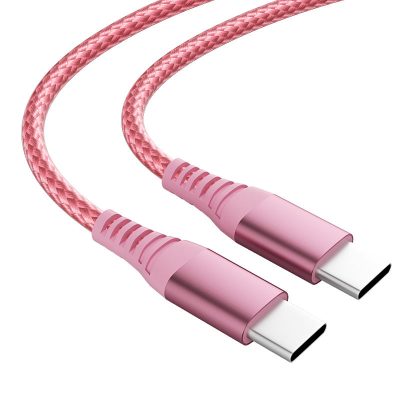USB C to C cables offer a range of advantages that make them increasingly popular for modern devices. Here are the key benefits of using USB C to C cables:
1. High-Speed Data Transfer
Efficient Data Transfer:
- USB 3.1 and Beyond: USB C to C cables can support data transfer speeds of up to 10 Gbps with USB 3.1 Gen 2, and up to 40 Gbps with USB4. This makes them ideal for transferring large files quickly, such as 4K videos and high-resolution images.
2. Enhanced Power Delivery
Fast Charging:
- Up to 100W Power Delivery: USB C to C cables can deliver up to 100 watts of power, enabling fast charging for laptops, tablets, smartphones, and other devices.
- Universal Charging: These cables can charge a wide range of devices, reducing the need for multiple chargers.
3. Universal Compatibility
Standardization:
- Broad Device Support: USB C is becoming the universal standard for new devices, ensuring compatibility across various brands and platforms.
- Cross-Platform Use: USB C to C cables can connect different types of devices, such as laptops, tablets, and smartphones, promoting a more seamless tech ecosystem.
4. Reversible Connector
User-Friendly Design:
- Easy Plugging: The reversible USB C connector eliminates the frustration of trying to plug in the cable the correct way, making it more convenient for everyday use.
- Consistent Connectivity: Ensures a secure and reliable connection every time, reducing wear and tear on ports and connectors.
5. Future-Proofing
Adaptability to New Technologies:
- Scalable Technology: USB C to C cables are designed to accommodate future advancements in data transfer rates and power delivery, ensuring they remain relevant as technology evolves.
- Longevity: Investing in USB C to C cables means being prepared for future devices and innovations, minimizing the need for frequent upgrades.
6. Improved Build Quality
Durability:
- Robust Construction: Many USB C to C cables are built with high-quality materials such as braided nylon and reinforced connectors, enhancing their durability and lifespan.
- Reliable Performance: Quality construction ensures consistent performance, reducing the likelihood of cable failures and connection issues.
7. Enhanced Functionality
Versatile Use:
- Audio and Video Support: USB C to C cables can carry audio and video signals, making them suitable for connecting monitors, docking stations, and other peripherals.
- Data and Power Combined: These cables can simultaneously handle data transfer and power delivery, streamlining connectivity and reducing cable clutter.
8. Eco-Friendly and Cost-Effective
Reducing E-Waste:
- Less Cable Waste: By standardizing on USB C, users need fewer cables and adapters, reducing electronic waste and promoting more sustainable tech practices.
- Economic Benefits: Over time, using universal USB C to C cables can reduce costs associated with purchasing multiple types of cables and chargers for different devices.
9. Security and Safety
Certified Standards:
- USB-IF Certification: Many USB C to C cables are certified by USB-IF (USB Implementers Forum), ensuring they meet strict standards for safety and performance.
- Safe Charging: Certified cables reduce the risk of overheating, short-circuiting, and other electrical issues, protecting both the devices and the users.
10. Improved Aesthetics and Organization
Neater Cable Management:
- Minimalist Design: With fewer types of cables needed, setups become more organized and visually appealing.
- Single Cable Solution: USB C to C cables can often replace multiple cables, reducing clutter and simplifying cable management.
Conclusion
USB C to C cables offer numerous advantages, including high-speed data transfer, enhanced power delivery, universal compatibility, and future-proof design. Their user-friendly and durable nature, coupled with broad device support and certified safety standards, make them an essential component in the evolving tech landscape. By adopting USB C to C cables, users can enjoy efficient, reliable, and versatile connectivity for a wide array of devices.







